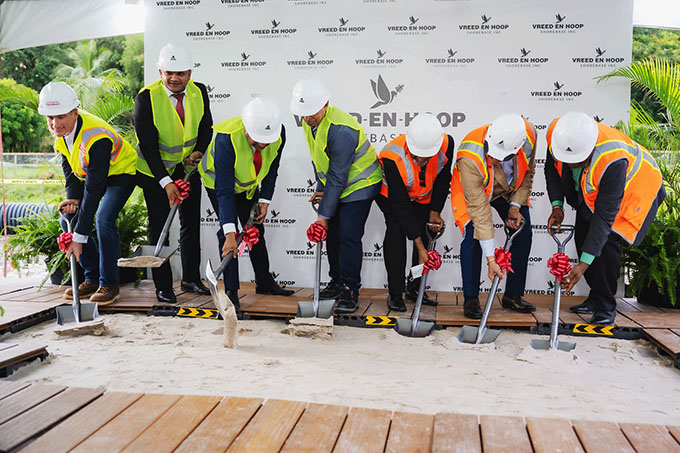Just about two months after it inked a pact with ExxonMobil to lease its planned US$300 million shore base facility to support its offshore oil operations, local consortium NRG Holdings Incorporated, on Tuesday, turned the sod to officially commence construction of the facility.
The shore base, which is being undertaken by Vreed-en-Hoop Shorebase Incorporated (VEHSI), is a component of the Port of Vreed-en-Hoop project. VEHSI is a joint venture between NRG Holdings Incorporated—a Guyanese-owned consortium comprising Hadi’s World Incorporated, National Hardware Limited and ZRN Investments Incorporated—and Jan De Nul, a Luxembourg-based engineering and construction firm that specialises in marine services, offshore services, civil engineering, environmental management activities and project development.
VEHSI serves as a Special Purpose Vehicle (SPV) for the 20-acre shore base. NRG Holdings Inc.—the developer of the Port of Vreed-en-Hoop project— holds an 85 per cent stake in the joint venture.
In April, VEHSI and ExxonMobil Guyana signed the agreement for shore base services to be provided at the Port of Vreed-en-Hoop Facility. This is the first shore base to begin construction in the region.
In a statement yesterday, the company said that the ‘MV Zheng He’ is the first dredge to arrive in Guyana for the construction of the Port of Vreed-en-Hoop project and entered the Demerara Port on June 4. The facility is expected to be completed by the fourth quarter of 2023.
Director of NRG Holdings, Nicholas Deygoo-Boyer in his remarks said that NRG Holdings is committed to working with residents to improve the community and bring employment opportunities in the oil and gas sector to the region.
The facility is expected to generate at least 300 jobs during the construction phase while the jobs generated during the operation phase will depend solely on the needs of Exxon. In April, Boyer had said that the construction methodology is heavy equipment-based, so there will be a demand for operators and equipment movers. He said that VEHSI is a sub-project of the Port of Vreed-en-Hoop masterplan and 85% of the shares are owned by Guyanese. The other 15% is held by the contractor Jan De Nul Group. The facility will occupy some 400 hectares of coastland.
Minister of Natural Resources, Vickram Bharrat, who delivered the feature remarks at the sod-turning event said, “With the call being answered by who I consider three young entrepreneurs who are taking the risk of investing into the Vreed-en-Hoop Shore base, I think they must be commended for taking this initiative.”
Immense benefits
He further remarked that the project will see immense benefits coming into Region Three, including employment and income-generating opportunities that will play a transformative role in developing the lives of residents. He commented that Guyana is forging ahead at a pace that has not been seen in many oil-producing countries, which will see the development of Guyana reaching new heights in the coming years.
Meanwhile, President of ExxonMobil Guyana, Alistair Routledge, noted that it was important for ExxonMobil and co-venturers: Hess Guyana Exploration Limited and CNOOC Petroleum Guyana Limited (CPGL) that the people of Guyana benefit from such projects.
“We are bringing opportunity into the country to develop oil and gas here with the support services… It’s also going to be the foundation for a much larger port project that the Directors have an ambition to build here, which will build more significant impact for the whole country,” he was quoted as saying.
The shore base development will include facilities such as general/heavy loading berths, storage/laydown yards, construction offices, mess hall, parking, and backup generators.
In April, Routledge had told reporters that VEHSI is an important project because it would enable investors in the oil and gas sector to do more. He said that VEHSI’s role will be different from that of Guyana Shore Base Incorporated (GYSBI) at Houston. GYSBI is Guyana’s first shore base facility and has enabled Exxon to move almost all of its supply chain for drilling and production operations from Trinidad to Guyana.
“What VEHSI allows us to do is to bring more of the construction activities, the preparation for installation of subsea equipment. Everybody tends to focus on the vessel that’s on the surface – the FPSO, but we put just as much investment on the seabed and into wells,” he had said.
He added that some of the fabrication of jumpers and steel plates to go on the seabed to connect the wells are being done in Guyana at a smaller facility – at SAIPEM – but with VEHSI coming on board that would increase capacity significantly.





